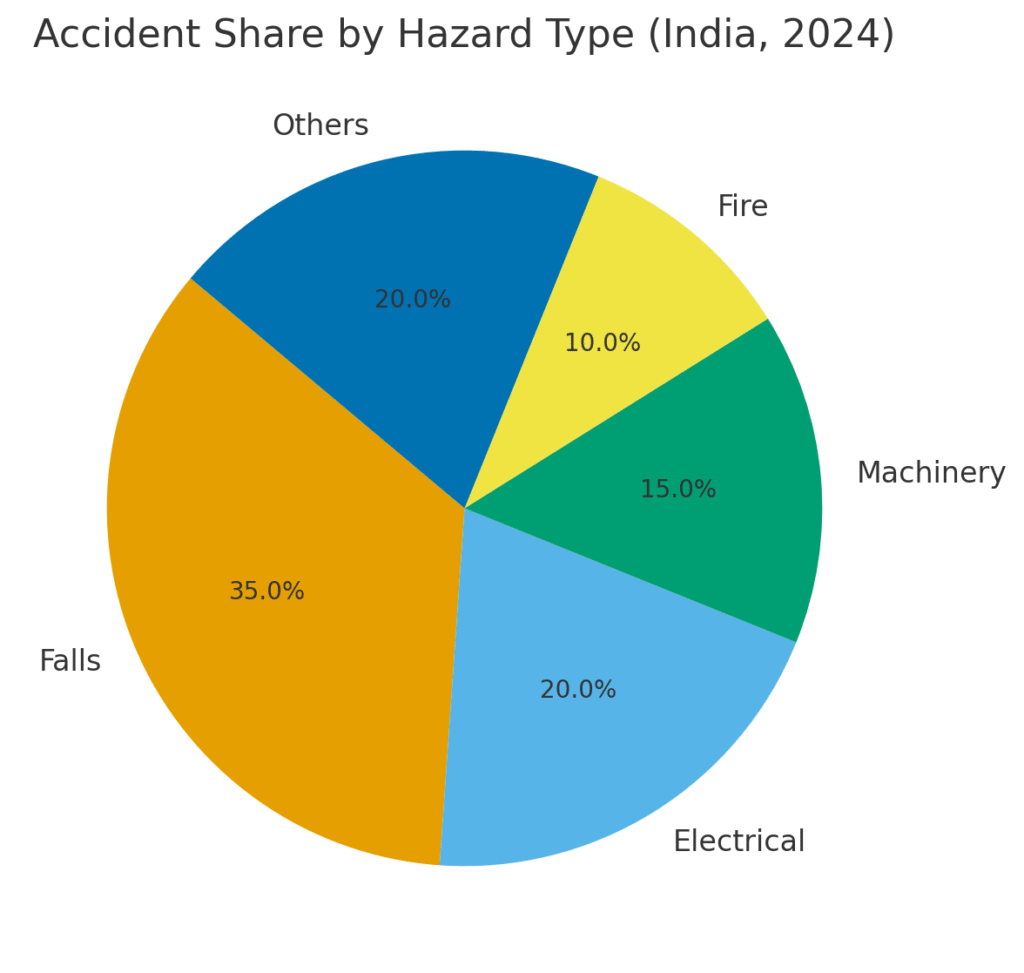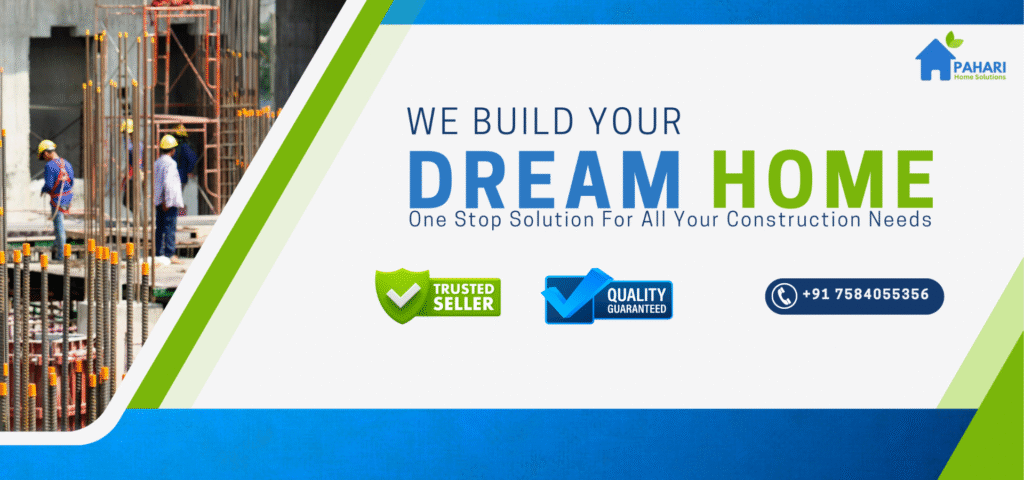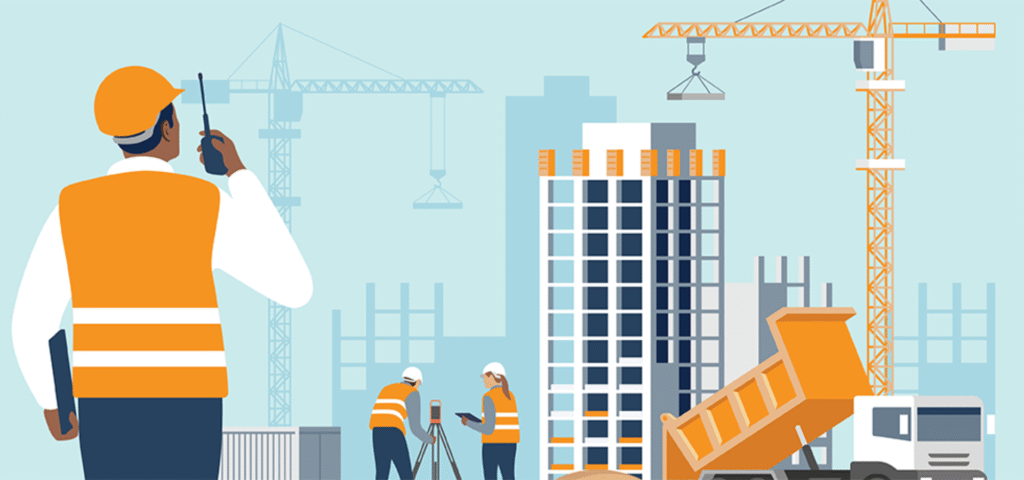Safety is not just a regulation — it’s a responsibility. Every construction site, whether it’s a residential house or a large commercial project, involves potential risks. From working at heights to handling heavy materials, construction workers face challenges every day that require strict adherence to safety guidelines.
This blog outlines the key safety measures, protocols, and compliance standards that every builder, contractor, and site manager should follow to ensure a secure, efficient, and accident-free work environment.
Understanding Construction Site Safety
Construction site safety refers to the set of procedures, policies, and protective measures designed to reduce workplace hazards. According to the National Building Code (NBC) and the Occupational Safety, Health and Working Conditions Code (2020), site safety is mandatory for all active construction zones.
The main objectives are:
- Prevent injuries and fatalities
- Promote a culture of awareness and responsibility
- Protect property and equipment
- Ensure compliance with Indian labor and safety laws
Major Safety Hazards on Construction Sites
| Category | Examples of Risk | Preventive Measures |
|---|---|---|
| Physical Hazards | Falling objects, noise, vibration | Use helmets, earplugs, and vibration control tools |
| Electrical Hazards | Faulty wiring, exposed cables | Regular inspections, insulated gloves, proper grounding |
| Chemical Hazards | Paints, adhesives, solvents | Use masks, ventilation, and material data sheets |
| Mechanical Hazards | Equipment misuse, moving machinery | Provide operator training, maintain machinery regularly |
| Height-related Risks | Working on scaffolds, ladders | Secure harnesses, guardrails, and fall protection systems |
| Fire Hazards | Welding sparks, fuel leaks | Keep extinguishers nearby, restrict smoking areas |
Essential Personal Protective Equipment (PPE)
Every worker must be equipped with Personal Protective Equipment (PPE) as per the Bureau of Indian Standards (BIS) norms.
| Type of PPE | Purpose | Example |
|---|---|---|
| Head Protection | Protects against falling debris | Safety helmets (IS 2925) |
| Eye & Face Protection | Shields from dust and sparks | Goggles, face shields |
| Respiratory Protection | Filters dust and fumes | N95 mask, respirators |
| Hand Protection | Prevents cuts and burns | Rubber or leather gloves |
| Foot Protection | Prevents crush and slip injuries | Steel-toe boots |
| Body Protection | Shields from impact and chemicals | Reflective jackets, aprons |
| Fall Protection | Prevents falls from height | Full-body harnesses, lifelines |
Construction Site Safety Rules & Protocols
- Daily Safety Briefing — Conduct a toolbox talk before starting work.
- Restricted Entry — Only authorized personnel should enter active construction zones.
- Scaffold Safety — Inspect scaffolds daily before use.
- Electrical Safety — Use only tested and approved tools.
- Emergency Access — Keep exits and fire routes clear at all times.
- Signage & Marking — Display visible safety signs and caution boards.
- Proper Waste Disposal — Avoid construction debris piling up near work zones.
- Weather Awareness — Suspend work during storms or heavy rainfall.
Construction Accident Statistics (India)
| Year | Reported Accidents | Fatalities | Main Cause |
|---|---|---|---|
| 2019 | 870 | 302 | Falls from height |
| 2020 | 790 | 250 | Electrocution |
| 2021 | 920 | 310 | Equipment malfunction |
| 2022 | 950 | 340 | Scaffold collapse |
| 2023 | 1,050 | 375 | Negligence / Lack of PPE |
| 2024 | 1,200 | 410 | Human error & poor training |
Observation: While the construction sector is growing rapidly, accident numbers are also increasing due to lack of training and poor safety awareness. Proper safety training can reduce incidents by over 60%.

Safety Compliance Checklist
| Safety Area | Checklist | Compliant (✓/✗) |
|---|---|---|
| PPE Availability | Helmets, gloves, boots provided | ✓ |
| Fire Safety | Extinguishers placed and inspected | ✓ |
| Electrical Safety | Cables insulated and tagged | ✓ |
| Height Work | Scaffolds inspected daily | ✓ |
| Site Housekeeping | Clear walkways and debris-free | ✓ |
| First Aid | Trained personnel and kits on site | ✓ |
| Signage | Warning and directional signs | ✓ |
| Worker Training | Regular safety workshops | ✓ |
Importance of Safety Training
A safety-trained workforce is the backbone of any construction company. Workers should be trained in:
- Safe handling of tools and machinery
- Use of PPE
- Emergency evacuation procedures
- First aid and fire response
- Electrical safety and lockout-tagout (LOTO) systems
Training should be conducted monthly and documented for compliance audits.
Role of Contractors and Supervisors
Supervisors are responsible for:
- Conducting daily inspections
- Enforcing safety rules
- Reporting hazards immediately
- Maintaining safety logs and checklists
Contractors must ensure all subcontractors also follow the same safety standards.
Smart Safety Technology (2025 Trends)
Modern safety has evolved with technology. Builders in 2025 are adopting smart solutions like:
- IoT-based helmets — track worker movement and detect fatigue
- AI-based monitoring — predicts accident-prone zones
- Drones — for site inspection and surveillance
- Digital PPE trackers — ensure all workers wear safety gear
- Smart alarms — detect gas leaks, smoke, and vibration
These innovations are helping reduce site accidents by improving real-time awareness.
Pahari Home Solutions’ Commitment to Safety
As a trusted supplier of construction materials in Purba & Paschim Medinipur,
Pahari Home Solutions Pvt. Ltd. ensures every project we’re part of follows high safety standards.
We educate builders and contractors on:
- Safe material handling (TMT bars, cement, tiles, etc.)
- Proper storage and lifting methods
- Use of certified brands with BIS and ISO quality marks
Our mission: To help build safe, strong, and sustainable structures — one project at a time.
Contact Us
For construction materials, safety-compliant supplies, and consultation:
📞 +91 7584055356 (Call & WhatsApp)
📧 official@paharihomesolutions.in
🌐 www.paharihomesolutions.in
Pahari Home Solutions Pvt. Ltd. – One Stop Solution for All Your Construction Needs.

FAQs on Construction Site Safety
1. What is the most important safety rule on a construction site?
The most important rule is always wear PPE — helmets, gloves, boots, and reflective jackets. Most accidents occur because workers skip protective gear.
2. How can small construction projects ensure safety?
Even small sites must have fire extinguishers, first aid kits, and regular inspections. Contractors should train workers and maintain proper scaffolds and PPE.
3. What are the legal safety requirements in India for construction?
Indian construction sites must comply with the Building and Other Construction Workers (Regulation of Employment and Conditions of Service) Act, 1996, and the OSH Code 2020. Violations can lead to penalties or closure.
4. How often should safety training be conducted?
Ideally once a month, and before starting any new project phase. Training must include demonstrations, PPE checks, and hazard identification drills.
5. How can technology improve construction safety?
IoT devices, AI-based monitoring, and drones can detect unsafe zones, monitor PPE usage, and alert supervisors before accidents happen.
Conclusion : Building Safely for a Stronger Tomorrow
Construction safety is not an option — it’s a necessity that defines the quality, reliability, and longevity of every structure we build. From wearing the right PPE to maintaining strict site protocols and adopting smart safety technologies, every small action contributes to preventing accidents and saving lives.
A well-managed and safety-compliant site not only protects workers but also enhances productivity, reduces downtime, and builds a reputation of trust among clients and stakeholders. As India’s infrastructure grows rapidly, following Essential Safety Guidelines is the key to sustainable development and responsible construction.
At Pahari Home Solutions Pvt. Ltd., we believe that every strong foundation begins with safety. Our commitment goes beyond delivering high-quality materials — we advocate for safe practices at every stage of construction. Together, let’s build not just stronger structures, but safer futures.


